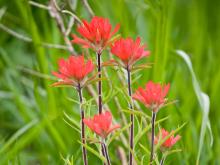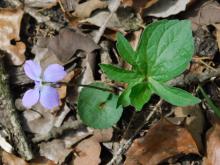Wildflowers, Grasses and Other Nonwoody Plants
Media

Species Types
Scientific Name
Phlox divaricata
Description
A common, eye-catching native spring wildflower common in woodlands, blue phlox occurs nearly statewide.
Media

Species Types
Scientific Name
Buchnera americana
Description
American bluehearts is a single or few-stalked wildflower of prairies and glades. It has distinctive, showy purple flowers that turn black as they age.
Media

Species Types
Scientific Name
Phlox bifida
Description
A spreading, mat-forming perennial of dry, rocky soils, sand phlox is distinguished from our other phloxes by its creeping habit and the deep, V-shaped notch on each of the five petal lobes.
Media

Species Types
Scientific Name
Viola sagittata
Description
Arrow-leaved violet, or arrowhead violet, is a native Missouri perennial spring wildflower that grows in prairies, glades, and woodland openings. It has distinctive arrowhead-shaped leaves.
Media

Species Types
Scientific Name
Lithospermum canescens
Description
Hoary puccoon's small, tubular flowers arise on spirally condensed stalks that uncoil and elongate as more flowers open toward the tip. Occurs nearly statewide in prairies, glades, pastures, roadsides, and other open areas.
Media

Species Types
Scientific Name
Castilleja coccinea
Description
The bright red of Indian paintbrush colors our native prairielands, reminding us (through its name) of the Osage, Kansa, Pawnee, and many other people who lived in these prairies before the pioneers.
Media

Species Types
Scientific Name
Viola pedata
Description
In springtime, bird's-foot violet can make a glade or bluff top heavenly with its pretty lavender and purple "faces." When you see your first big colony of bird's-foot violets, you will probably never forget it.
Media

Species Types
Scientific Name
Primula meadia (syn. Dodecatheon meadia)
Description
A beloved native spring wildflower, shooting star makes a lasting impression on hikers who encounter a nice big colony of these downward-pointing pink, white, or purplish flowers.
Media

Species Types
Scientific Name
Viola palmata (syn. V. triloba)
Description
The leaf blades of cleft violet are highly variable, and the plant produces differently shaped leaves as the season progresses. Midseason leaves have a broad central lobe flanked by additional lobes toward the base.
Media

Species Types
Scientific Name
Hesperis matronalis
Description
Dame’s rocket has showy clusters of purple flowers that bloom atop waist-high stalks in April, May, and June. A native of Eurasia, this member of the mustard family was introduced as a garden flower. It commonly escapes from cultivation.
See Also
About Wildflowers, Grasses and Other Nonwoody Plants in Missouri
A very simple way of thinking about the green world is to divide the vascular plants into two groups: woody and nonwoody (or herbaceous). But this is an artificial division; many plant families include some species that are woody and some that are not. The diversity of nonwoody vascular plants is staggering! Think of all the ferns, grasses, sedges, lilies, peas, sunflowers, nightshades, milkweeds, mustards, mints, and mallows — weeds and wildflowers — and many more!





















